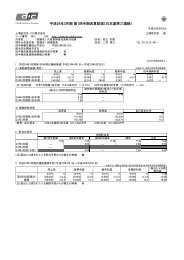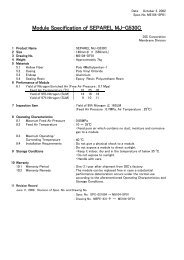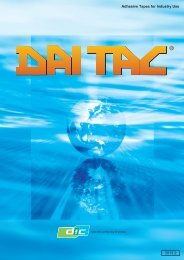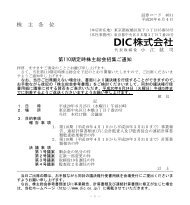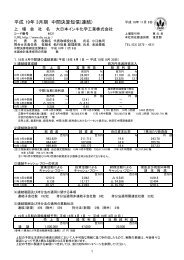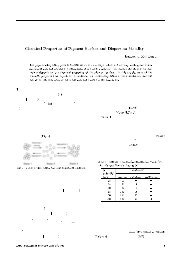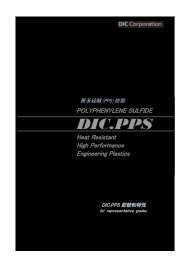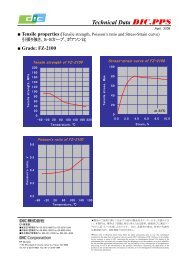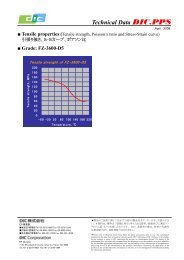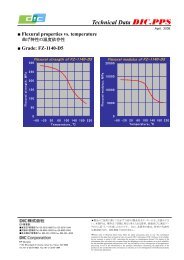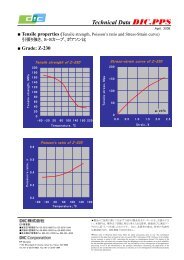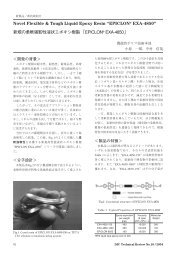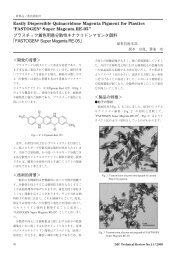in English [PDF:599KB] - Dainippon Ink and Chemicals, Inc
in English [PDF:599KB] - Dainippon Ink and Chemicals, Inc
in English [PDF:599KB] - Dainippon Ink and Chemicals, Inc
You also want an ePaper? Increase the reach of your titles
YUMPU automatically turns print PDFs into web optimized ePapers that Google loves.
Design<strong>in</strong>g of DVD Bond<strong>in</strong>g Adhesive <strong>and</strong> Its Chemical Properties<br />
MURAKAMI Kazuo <strong>and</strong> KITSUNAI Takashi<br />
In order to improve DVD-9 durability, the authors have been <strong>in</strong>vestigat<strong>in</strong>g chemical properties of<br />
bond<strong>in</strong>g adhesive. In the case of DVD-9, two different materials such as alum<strong>in</strong>um <strong>and</strong> gold are<br />
used for reflective layer. So, if adhesive does not work well as <strong>in</strong>sulator, alum<strong>in</strong>um corrosion can be<br />
accelerated by electrolysis under high temperature <strong>and</strong> high humidity condition. These<br />
speculations brought us to measure "specific conductivity for water <strong>in</strong> which the cured adhesive<br />
film has been immersed" (SCW) <strong>and</strong> to evaluate the cured adhesive film by measur<strong>in</strong>g "thermally<br />
stimulated current" (TSC) if the current can be observed. It was found out that the adhesive with<br />
certa<strong>in</strong> range of these two parameters could improve DVD-9 durability.<br />
1 INTRODUCTION<br />
DVD-ROMs are available <strong>in</strong> four formats, such as<br />
DVD-5, DVD-10, DVD-9 <strong>and</strong> DVD-18. Of these, DVD-9 is<br />
becom<strong>in</strong>g major format <strong>in</strong> the market because of its<br />
high capacity <strong>and</strong> suitable structure that can read two<br />
<strong>in</strong>formation layers from one side.<br />
Fig.1 shows a DVD bond<strong>in</strong>g process. DVD is<br />
produced by bond<strong>in</strong>g two polycarbonate substrates<br />
with UV curable adhesive. Each substrate has th<strong>in</strong><br />
sputtered reflective layer of <strong>in</strong>organic material such as<br />
alum<strong>in</strong>um, gold, silicon, silver or silver alloy,<br />
depend<strong>in</strong>g on DVD format. In the case of DVD-9, one<br />
of the substrate is sputtered with alum<strong>in</strong>um <strong>and</strong> the<br />
other has semitransparent layer sputtered with gold,<br />
silicon, silver or silver alloy.<br />
Mak<strong>in</strong>g reliable DVD is the most concern<strong>in</strong>g issue for<br />
DVD manufacturers. In the whole production<br />
processes, mold<strong>in</strong>g, sputter<strong>in</strong>g <strong>and</strong> bond<strong>in</strong>g are three<br />
essential processes <strong>and</strong>, <strong>in</strong> fact, adhesive is the key<br />
material for log term reliable DVD<br />
Dur<strong>in</strong>g the very beg<strong>in</strong>n<strong>in</strong>g stage of adhesive<br />
development for DVD-9 (Au/Al), we encountered that,<br />
<strong>in</strong> some cases, DVD-10, which is bonded two<br />
polycarbonate substrates sputtered with alum<strong>in</strong>um,<br />
<strong>and</strong> DVD-9 showed different result after durability test<br />
under high temperature <strong>and</strong> high humidity conditions,<br />
even though us<strong>in</strong>g same adhesive. Electrical signal<br />
from alum<strong>in</strong>um layer of DVD-9 is always worse than<br />
that of DVD-10.<br />
Consider<strong>in</strong>g the above unexpected results, we had<br />
reached the hypothesis that adhesive layer might work<br />
as conductive material under high temperature <strong>and</strong><br />
high humidity conditions so that gold <strong>and</strong> alum<strong>in</strong>um<br />
layer could connect each other electrically. When the<br />
temperature is <strong>in</strong>creased <strong>and</strong> adhesive layer absorb<br />
water, several k<strong>in</strong>ds of impurities could move <strong>in</strong> the<br />
adhesive layer. So, under the durability test condition,<br />
8095%RH, it might be possible to form battery<br />
<br />
DIC Technical Review No.10 / 2004 25
<strong>in</strong> DVD-9 disc <strong>and</strong> corrosion of the alum<strong>in</strong>um layer<br />
could accelerate due to its lower st<strong>and</strong>ard electrode<br />
potentials. 1)<br />
Based on these considerations, we have measured<br />
specific conductivity for water <strong>in</strong> which the cured<br />
adhesive film has been immersed(SCW) <strong>and</strong> also<br />
evaluated the cured adhesive film by thermally<br />
stimulated current(TSC) <strong>in</strong> order to characterize the<br />
chemical properties of adhesive.<br />
In this paper, the relationships between DVD-9<br />
durability <strong>and</strong> the two parameters, SCW <strong>and</strong> TSC, are<br />
reported.<br />
2 EXPERIMENTAL<br />
2.1 Measurement of specific conductivity<br />
Adhesive samples were prepared by acrylic<br />
compounds such as acrylic oligomers, acrylic<br />
monomers <strong>and</strong> photo <strong>in</strong>itiators. As oligomers,<br />
bisphenol A type epoxy acrylate <strong>and</strong> urethane acrylate<br />
are employed.<br />
Then these samples were cured by two different UV<br />
irradiation methods. The procedures are as follows:<br />
- A glass plate is coated with a test adhesive <strong>in</strong> a<br />
thickness of about 100 m, then placed <strong>in</strong> a nitrogen<br />
atmosphere <strong>and</strong> irradiated by metal halide lamp (MH)<br />
or UV flash irradiator (UVFI).<br />
- In the case of MH, irradiation of 0.5 J/cm 2 is carried<br />
out at lamp height of 10 cm.<br />
- In the case of UVFI, 10 shots of irradiation are<br />
carried out.<br />
- The cured coat<strong>in</strong>g film peeled off from the glass<br />
plate is cut <strong>in</strong> size of about 1 to 2 cm square <strong>and</strong> about<br />
1 g of it is placed <strong>in</strong> a 250 ml brown plastic bottle.<br />
- 100 g of pure water that is purified to 18 Mcm is<br />
added to the bottle, <strong>and</strong> it is stored <strong>in</strong> a oven at 80<br />
for 96 hours.<br />
- SCW is measured at 25 1 us<strong>in</strong>g CM-50A<br />
Conductivity Meter. (TOA Electronics, Ltd.)<br />
- SCW was calculated by the follow<strong>in</strong>g equation:<br />
SCW = SCW(m) /weight of cured adhesive film<br />
[SCW(m) = observed value of SCW]<br />
Characteristics of each sample are summarized <strong>in</strong><br />
Table 1.<br />
2.2 Measurement of TSC<br />
Adhesive samples were poured <strong>in</strong>to the glass cell<br />
with ITO electrode <strong>and</strong> cured by metal halide lamp.<br />
The <strong>in</strong>strument set for the study was TSC/RMA9000<br />
(Syscom). Conditions of the measurements are shown<br />
<strong>in</strong> Fig.2: Tp = 25, To = -50, Tf = 100, heat<strong>in</strong>g rate<br />
is 5 /m<strong>in</strong>, <strong>and</strong> pol<strong>in</strong>g voltage is 100 V/mm. When<br />
pol<strong>in</strong>g voltage was applied at Tp, polarization of the<br />
sample aligned to the direction of electric field. Dur<strong>in</strong>g<br />
the heat<strong>in</strong>g process from To, the depolarization<br />
current was recorded by a sensitive electrometer. 2)<br />
2.3 Durability test on DVD-9<br />
DVD-9 discs were prepared as follows:<br />
- On polycarbonate substrate sputtered with<br />
alum<strong>in</strong>um, adhesive sample was coated with a<br />
dispenser, <strong>and</strong> then this substrate was overlaid with a<br />
polycarbonate substrate sputtered with gold as a<br />
semitransparent layer.<br />
- The disc was rotated at 1500 rpm for 5 to 6 seconds<br />
to spread out 50-60 m film.<br />
- In the case us<strong>in</strong>g metal halide lamp (Eye Graphics,<br />
model MO3-L31, 120 W/cm, with a cold mirror),<br />
<br />
<br />
<br />
<br />
<br />
<br />
<br />
<br />
<br />
26 DIC Technical Review No.10 / 2004
adhesive was cured by 1.0 J/cm 2 .<br />
- In the case us<strong>in</strong>g UV flash irradiator (Ushio flash<br />
lamp, model SBC-13), adhesive was cured by 10 shots.<br />
Durability test on DVD-9 was conducted at 80<br />
95%RH for 96 hours <strong>and</strong> 300 hours. The discs were<br />
evaluated by measur<strong>in</strong>g PI error rate <strong>and</strong> the durability<br />
of each disc was compared by the ratio of PI error<br />
rates before <strong>and</strong> after the test.<br />
3 RESULTS AND DISCUSSION<br />
3.1 Relation between SCW <strong>and</strong> durability of<br />
DVD-9<br />
As shown <strong>in</strong> Fig.3 <strong>and</strong> Fig.4, SCW data is apparently<br />
depended on samples. For example, Sample 3 <strong>and</strong> 4<br />
showed small difference, but sample 5 <strong>and</strong> 6 showed<br />
larger.<br />
Durability test results on DVD-9 are also shown <strong>in</strong><br />
Fig. 5, Fig.6. In all samples, PI error of L0 (Au) side<br />
looked very stable even after 300 hours. On the other<br />
h<strong>and</strong>, PI error of sample 5 <strong>and</strong> 6 dramatically<br />
<strong>in</strong>creased <strong>in</strong> L1 (Al) side after 96 hours <strong>and</strong> completely<br />
failed after 300 hours.<br />
SCW data <strong>and</strong> durability test data (PI error <strong>in</strong>crease<br />
ratio) for sample 1 to 6 are summarized <strong>in</strong> Table 2.<br />
SCW data of water <strong>in</strong> which the cured coat<strong>in</strong>g film<br />
has been immersed were below 80 S/cm for the<br />
sample 1 to 4. And durability test results on DVD-9<br />
bonded with these 4 samples showed substantially no<br />
change <strong>in</strong> PI error <strong>and</strong> exhibited excellent durability<br />
after 96 hours. Furthermore, sample 3 <strong>and</strong> 4 show<strong>in</strong>g<br />
SCW below 50 S/cm also resulted <strong>in</strong> no substantial<br />
change <strong>in</strong> PI error after 300 hours.<br />
3.2 Relation between TSC <strong>and</strong> durability of<br />
DVD-9<br />
In general, the specific conductivity of water<br />
<br />
<br />
<br />
<br />
DIC Technical Review No.10 / 2004 27
detected by TSC <strong>in</strong> the adhesive film under elevated<br />
temperature. So, this fact could strongly support our<br />
hypothesis that the corrosion of alum<strong>in</strong>um layer could<br />
be accelerated by <strong>in</strong>duced battery <strong>in</strong> DVD-9 disc.<br />
Based on these technical po<strong>in</strong>ts of view, we have<br />
been develop<strong>in</strong>g DVD adhesives <strong>and</strong> launched SD-645<br />
(Da<strong>in</strong>ippon <strong>Ink</strong> <strong>and</strong> <strong>Chemicals</strong>, <strong>Inc</strong>.) <strong>and</strong> its improved<br />
version SD-661 (Da<strong>in</strong>ippon <strong>Ink</strong> <strong>and</strong> <strong>Chemicals</strong>, <strong>Inc</strong>.) <strong>in</strong><br />
the market. 3)<br />
<br />
ACKNOWLEDGEMENT<br />
The authors would like to express appreciation to<br />
Mr. Toru Fujisawa for his help with the measurement<br />
of TSC.<br />
depends on the amount of water-soluble impurities<br />
eluted from the cured adhesive film. Therefore, SCW<br />
could <strong>in</strong>dicate the amount of water-soluble impurities<br />
<strong>and</strong> SCW could be used as a parameter to presume<br />
DVD-9 durability.<br />
Fig. 7 shows TSC profiles of sample 1 <strong>and</strong> 6. It was<br />
found that the current peak of sample 6 is higher than<br />
that of sample 1. In other words, it was assumed that<br />
total amount of carrier <strong>in</strong> adhesive 6 is much more<br />
than that <strong>in</strong> adhesive 1. In comparison with the result<br />
of durability test on DVD-9 described <strong>in</strong> Table 2,<br />
sample 6, which had higher current peak by TSC than<br />
sample 1, apparently showed poorer durability. So,<br />
TSC could also be used as a parameter to presume<br />
DVD-9 durability.<br />
This is the revision of the paper that was published <strong>in</strong><br />
the proceed<strong>in</strong>g of RadTech Asia 03 at Pacifico<br />
Yokohama, Japan.<br />
REFERENCES<br />
1) T. Osaka, N. Oyama, T. Ohsaka, Denki Kagaku Hou<br />
(Electrochemical Method), Kodansha CO., Ltd.<br />
(1990).<br />
2) J. R. Saffell, A. Matthiesen, R. McIntyre,<br />
Thermochimica Acta, 192 (1991) 243-264.<br />
3) Da<strong>in</strong>ippon <strong>Ink</strong> <strong>and</strong> <strong>Chemicals</strong>, USP 6,444,285.<br />
4 CONCLUSION<br />
It is concluded that DVD-9 bonded with the adhesive,<br />
which shows below 80 S/cm of SCW, or shows<br />
below 1.0 nA of the TSC current peak could perform<br />
excellently <strong>in</strong> terms of DVD-9 durability.<br />
Actually, even though it was very weak, current was<br />
<br />
<br />
<br />
<br />
<br />
<br />
<br />
<br />
<br />
28 DIC Technical Review No.10 / 2004


![in English [PDF:599KB] - Dainippon Ink and Chemicals, Inc](https://img.yumpu.com/37641148/1/500x640/in-english-pdf599kb-dainippon-ink-and-chemicals-inc.jpg)
